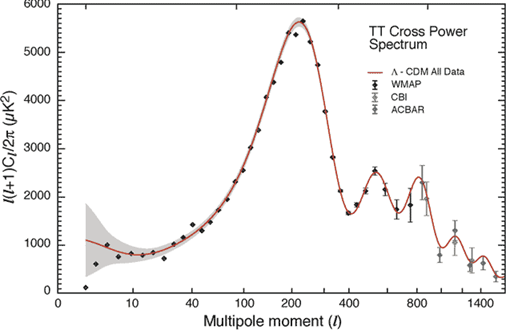
| The picture above shows the power spectrum of the CMB as measured by WMAP and the ground-based experiments CBI and ACBAR. Explain, quantitatively if possible, | |
| (i) why the main peak is at an angular scale ∼1°, and what cosmological parameter is measured by the position of the peak; | [4] |
|
There are a couple of sensible ways to do the calculation required for the
"quantitative" aspect: you can go for the horizon distance at CMB emission,
3c×400,000 years = 1.2 Mly, and expand this to its current dimensions:
1.2 Mly × 1100 = 1.3 Gly. Then divide this by the current horizon distance,
2c/H0 = 2c×14 Gyr = 28 Gly: 1.3/28 = 0.046 rad = 2.7°. This is
a bit large, because the actual relevant horizon is the sound horizon rather
than the light horizon, and they turn out to differ by a factor of 3, so 2.7°
turns into 0.9°. Alternatively, you can say that in a matter-dominated flat universe H(t)2 = H02/a3 = H02 × (1+z)3, so the Hubble distance c/H at redshift 1100 is given by c/(H0 × (1+z)3/2) = 380000 ly, divided by the angular size distance to z = 1100. The proper distance to (1+z) = 1100 is (2c/H0) × (1 – (1+z)–1/2) = 27 Gly, so the angular size distance is 27/1100 = 0.025 Gly = 25 Mly. Hence the angle in question is 0.38/25 = 0.015 rad = 1°. (This gives the right answer because we've sneakily used the Hubble distance c/H0 instead of the horizon distance 2c/H0!). Whichever calculation you do, you argue that this is the order-of-magnitude estimate for a flat, matter-dominated universe, and then say that the actual value depends on the cosmological model adopted. It turns out that the dominant factor in determining this angle is the total matter density, Ωtot = Ωr + Ωm + ΩΛ, so the position of the peak primarily measures the curvature. |
[4] |
| (ii) how the smaller peaks can be used to distinguish between baryonic and non-baryonic contributions to the density. | [3] |
| The higher peaks are the result of "acoustic oscillations" of the photon-baryon fluid. Since baryons contribute density but not pressure to the fluid equation, they tend to enhance compression peaks (odd numbered) over rarefaction peaks (even numbered). | [1] |
| Dark matter doesn't couple to the photons and just damps the oscillation, tending to make all the peaks smaller. | [1] |
| Therefore, measuring the relative sizes of the second and third peaks to the main peak will distinguish baryonic and non-baryonic contributions to the density. | [1] |
(2005, part of Q8.)